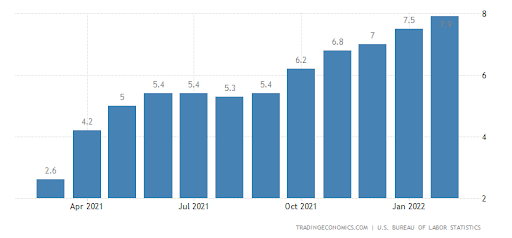Most financial advisors recommend a passive investment strategy to minimize costs and maximize returns over the long run. While securities in normal markets rise or fall together, inflation and rising interest rates widen the gap between winners and losers. As a result, actively-managed exchange-traded funds (ETFs) have become more popular.
Let’s take a closer look at what’s driving the move into active ETFs and what it means for investors moving forward.
See our Active ETFs Channel to learn more about this investment vehicle and its suitability for your portfolio.
Inflation & Interest Rates
Investors have become accustomed to low interest rates since the 2008 financial crisis. But, of course, the COVID-19 pandemic, supply chain crisis, and Russian invasion of Ukraine have culminated in the highest inflation levels since the 1980s. And the Federal Reserve has embarked on an aggressive plan to increase interest rates in response.

Inflation has been on the rise. Source: TradingEconomics
Rising interest rates have a predictable effect on many markets:
- Bonds and other fixed-income investments decrease in value as investors sell them to buy higher-yielding securities.
- Banks tend to increase in value because they earn more interest on their investments and charge higher rates to borrowers.
- Energy companies benefit from higher interest rates and inflation as well because the absolute value of commodities remains the same.
Passively-managed funds cannot take advantage of these predictable effects. For instance, the SPDR S&P 500 Index Fund (SPY) must mimic the S&P 500 index. Only actively-managed funds have the ability to cycle in and out of different industries and sectors based on how they will respond to higher interest rates in the future.
Reducing Risk & Volatility
Rising interest rates aren’t the only factor influencing the move to actively-managed ETFs. After Russia invaded Ukraine, many investors sought to reduce their portfolio risk. After all, volatile energy prices and the potential for chemical or nuclear weapon use could cause a significant drop in the stock market.
Actively-managed funds can also help reduce volatility amid ongoing geopolitical uncertainty. For example, long-short equity ETFs take long and short positions to minimize market exposure. The actively managed First Trust Long/Short Equity ETF (FTLS), for instance, is about 93% long and 37% short, resulting in 56% net exposure to the market.
Other actively-managed ETFs use options to limit downside risk. An excellent example is the Simplify U.S. Equity PLUS Downside Convexity ETF (SPD), which systematically overlays options to create a convex equity payoff if the market falls. Covered call ETFs can also build a cash cushion to soften any economic decline with option premiums.
Fixed Income Drives the Move
Fixed income is the most obvious choice for active management. With inflation at nearly 8% in February 2022, the Federal Reserve has made it clear that it intends to raise interest rates at an unprecedented rate in 2022 and 2023. As a result, there’s a very high likelihood that fixed-income investments will lose value—particularly if they’re high duration.
Active managers can mitigate the impact of rising interest rates by selecting low-duration bonds and cherry-picking high-yield bonds that can help offset the losses without increasing risk. They can also selectively choose bonds within sectors that could benefit from higher interest rates, reducing credit risk across their portfolios.
In addition to better strategy, the SEC’s adoption of new ETF rules in 2019 made it easier to launch active ETFs. The new rules make it cheaper and faster to bring new ETFs to market while enabling active managers to shield the real-time holdings of their funds for competitive reasons. As a result, more mutual funds are converting into an ETF structure.
Last year, actively-managed ETFs represented 11% of total assets within the fixed income ETF space but brought in 14% of the inflows, according to ETF Trends. The hawkish tone of the Federal Reserve and rising geopolitical risks stemming from the Russian invasion of Ukraine could accelerate these trends through 2022.
Don’t forget to explore our Dividend Guide where you can access all the relevant content and tools available on Dividend.com based on your unique requirements.
The Bottom Line
Active ETFs have become increasingly popular thanks to rising interest rates and geopolitical risks. In particular, fixed income has seen a significant increase in active fund flows as investors look to mitigate potential downside from rising interest rates and achieve higher yields without indiscriminately investing in junk bonds.
Take a look at our recently launched Model Portfolios to see how you can rebalance your portfolio.

